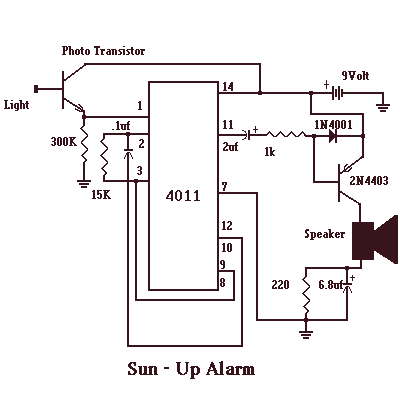
Sun-Up Alarm

The Sun-Up Alarm can be used to provide an audible alarm for when the sun comes up or it can be used in a dark area and detect when a light comes on. It can also be used to detect a light beam, headlights, etc. The circuit works as follows. The phototransistor is very sensitive to light. (Any phototransistor will work fine) The sun shining on this device will provide a high to one of the NAND gates. This will cause another NAND gate to oscillate which will drive another gate to output a 100Hz tone. The transistor provides drive for the speaker.
The Sun-Up Alarm circuit utilizes a phototransistor as the primary light detection component. The choice of phototransistor can be flexible, allowing for various models that match the sensitivity requirements of the application. When exposed to sunlight or a significant light source, the phototransistor conducts, creating a high logic level at its output. This output is connected to the first NAND gate in the circuit.
The first NAND gate's output, receiving a high signal from the phototransistor, enables the second NAND gate to oscillate. The oscillation frequency is determined by the feedback network connected to the second NAND gate, which is designed to produce a square wave at a frequency of approximately 100Hz. This oscillation serves as the basis for generating the audible alarm tone.
The output from the second NAND gate is then fed to a third NAND gate, which acts as a buffer and amplifier stage. This gate drives a transistor that is connected to a speaker. The transistor amplifies the oscillating signal, providing sufficient current to drive the speaker effectively. The result is a clear, audible tone that can alert users when the light condition changes, indicating sunrise or the presence of an artificial light source in a dark environment.
In summary, the Sun-Up Alarm circuit is a straightforward yet effective design that leverages basic digital logic components and a phototransistor to create an audible alarm system. The simplicity of the design allows for easy modifications and adaptations for various applications, making it a versatile tool for light detection and alarm signaling.The Sun-Up Alarm can be used to provide a audible alarm for when the sun comes up or it can be used in a dark area and detect when a light comes on. It can also be used to detect a light beam, headlights etc. The circuit works as follows. The phototransistor is very sensitive to light. (Any phototransistor will work fine) The sun shining on this device will provide a high to one of the NAND gates.
This will cause another NAND gate to oscillate which will drive another gate to output a 100hz tone. The transistor provides drive for the speaker. 🔗 External reference
The Sun-Up Alarm circuit utilizes a phototransistor as the primary light detection component. The choice of phototransistor can be flexible, allowing for various models that match the sensitivity requirements of the application. When exposed to sunlight or a significant light source, the phototransistor conducts, creating a high logic level at its output. This output is connected to the first NAND gate in the circuit.
The first NAND gate's output, receiving a high signal from the phototransistor, enables the second NAND gate to oscillate. The oscillation frequency is determined by the feedback network connected to the second NAND gate, which is designed to produce a square wave at a frequency of approximately 100Hz. This oscillation serves as the basis for generating the audible alarm tone.
The output from the second NAND gate is then fed to a third NAND gate, which acts as a buffer and amplifier stage. This gate drives a transistor that is connected to a speaker. The transistor amplifies the oscillating signal, providing sufficient current to drive the speaker effectively. The result is a clear, audible tone that can alert users when the light condition changes, indicating sunrise or the presence of an artificial light source in a dark environment.
In summary, the Sun-Up Alarm circuit is a straightforward yet effective design that leverages basic digital logic components and a phototransistor to create an audible alarm system. The simplicity of the design allows for easy modifications and adaptations for various applications, making it a versatile tool for light detection and alarm signaling.The Sun-Up Alarm can be used to provide a audible alarm for when the sun comes up or it can be used in a dark area and detect when a light comes on. It can also be used to detect a light beam, headlights etc. The circuit works as follows. The phototransistor is very sensitive to light. (Any phototransistor will work fine) The sun shining on this device will provide a high to one of the NAND gates.
This will cause another NAND gate to oscillate which will drive another gate to output a 100hz tone. The transistor provides drive for the speaker. 🔗 External reference





